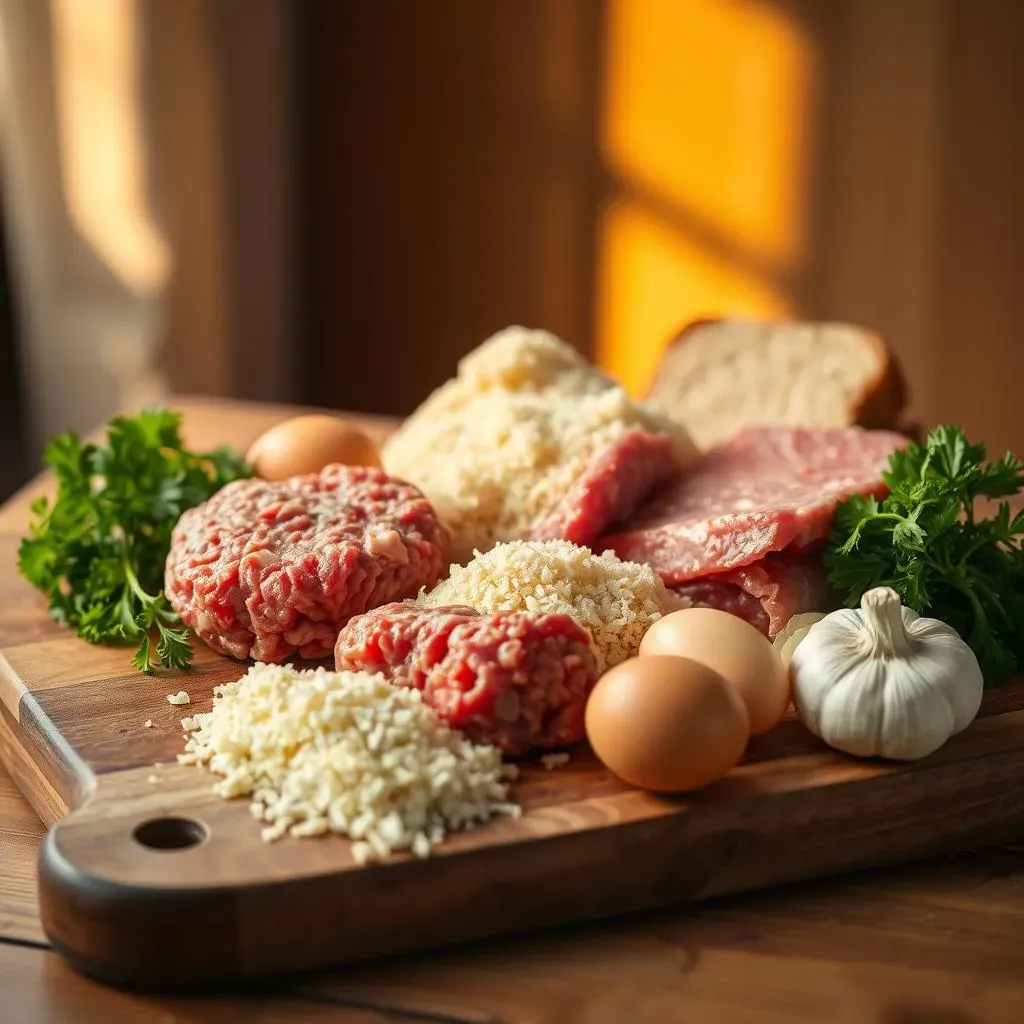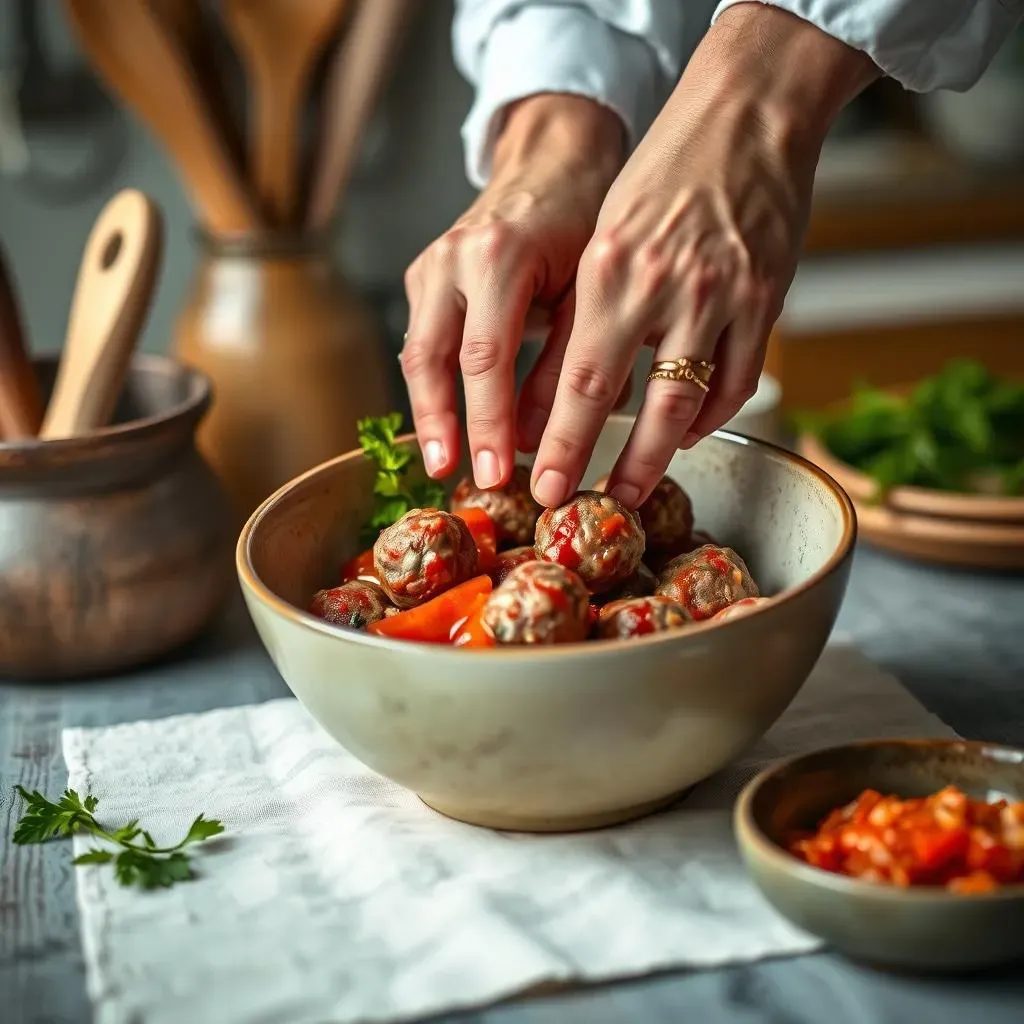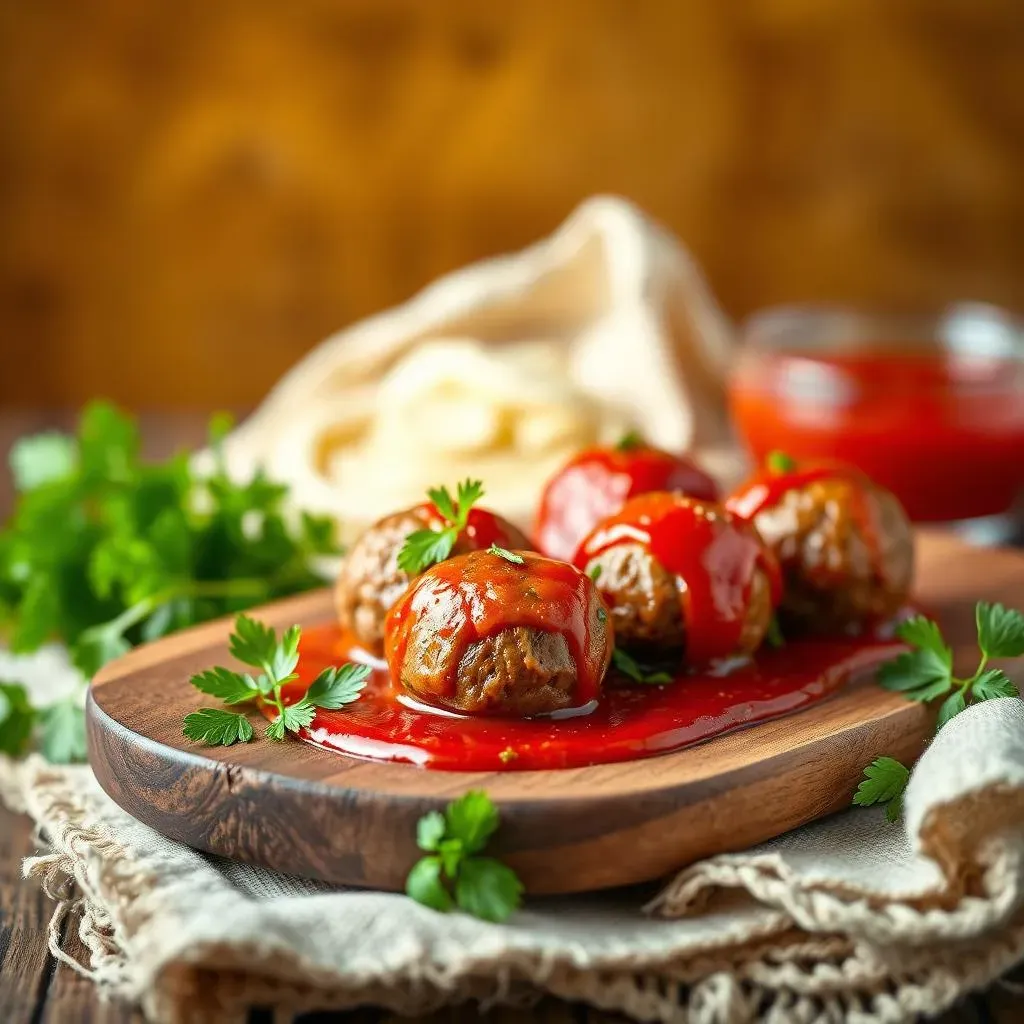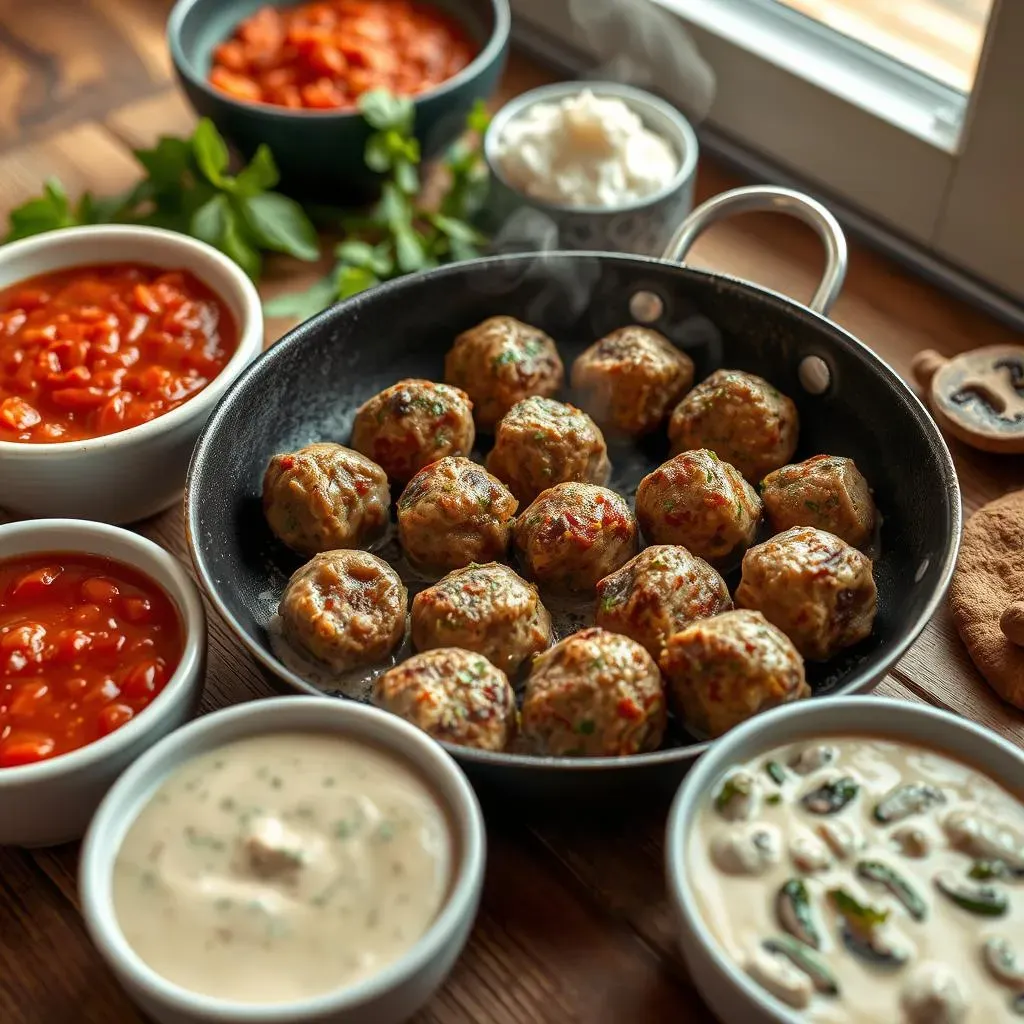Table of Contents
Looking for the best Italian meatball recipe? You've landed in the right spot! Forget dry, flavorless meatballs – this recipe is all about achieving juicy, tender perfection. We're diving deep into the secrets behind restaurant-quality meatballs, from the perfect blend of ingredients to the techniques that guarantee a melt-in-your-mouth texture. This isn't just another recipe; it's a culinary journey. We'll explore the science behind why certain ingredients work wonders, offer simple substitutions to suit your taste, and provide a step-by-step guide that even a novice cook can follow. Get ready to impress your family and friends with the most delicious Italian meatballs they've ever tasted. We'll cover everything from ingredient selection to cooking methods, ensuring your success every time. So, grab your apron, and let's get started on creating the best Italian meatball recipe you'll ever need!
Ingredients for the Best Italian Meatball Recipe

Ingredients for the Best Italian Meatball Recipe
The Meat: Choosing Your Ground
Let's kick things off with the heart of any meatball: the meat! For the best Italian meatball recipe, I'm a big fan of using a blend. Ground beef is a must, and I typically aim for an 80/20 blend – that little bit of extra fat keeps things juicy and flavorful. But here's where you can get creative. Adding ground pork brings a fantastic richness and depth. Some people even throw in ground veal for a truly authentic Italian flavor. Experiment and see what you like best! Just remember, the leaner the meat, the drier the meatball. And nobody wants a dry meatball.
Binders and Breadcrumbs: Holding It All Together
Now, let's talk about what holds everything together. Breadcrumbs are essential, but not just any breadcrumbs will do. I prefer using fresh breadcrumbs made from good-quality Italian bread. The texture is just better, and they soak up the moisture beautifully. Eggs are another crucial binder, helping to create a cohesive mixture. But here's the secret weapon: a panade. A panade is a mixture of bread soaked in milk (or even water) and then mixed into the meatball mixture. This creates an incredibly moist environment, ensuring tender meatballs every time. Trust me, don't skip the panade!
Flavor Boosters: Herbs, Cheese, and Aromatics
Alright, now for the fun part: flavor! This is where you can really customize your best Italian meatball recipe. Fresh herbs are a must. I love using a combination of parsley, oregano, and basil. Finely minced garlic is non-negotiable, adding that classic Italian punch. And don't forget the cheese! Parmesan cheese is my go-to, adding a salty, umami richness. Some people also like to add a touch of Pecorino Romano for extra tang. Finally, a little bit of finely grated onion adds a subtle sweetness and depth. Don't be afraid to experiment with other herbs and spices, like red pepper flakes for a little heat or fennel seeds for a hint of licorice.
Ingredient | Amount | Purpose |
|---|---|---|
Ground Beef (80/20) | 1 pound | Base flavor and texture |
Ground Pork | 0.5 pound | Adds richness and depth |
Fresh Breadcrumbs | 1 cup | Binder and moisture |
Eggs | 2 large | Binder |
Milk | 1/4 cup | Panade for moisture |
Parmesan Cheese | 1/2 cup grated | Flavor and richness |
Garlic | 4 cloves minced | Aromatic flavor |
Fresh Parsley | 1/4 cup chopped | Freshness and flavor |
Dried Oregano | 1 teaspoon | Earthy flavor |
Salt & Pepper | To taste | Seasoning |
StepbyStep Guide: Making the Best Italian Meatballs

StepbyStep Guide: Making the Best Italian Meatballs
Mixing Like a Pro: Getting the Right Consistency
Alright, let's get our hands dirty! In a large bowl, gently combine all your ingredients. Remember, we're aiming for a light and airy texture, so don't overmix! Overmixing will result in tough meatballs, and nobody wants that. Use your hands to gently incorporate everything until just combined. The mixture should be moist but not wet. If it seems too wet, add a little more breadcrumbs. If it seems too dry, add a splash of milk. Think of it like Goldilocks – you want it just right!
Once everything is mixed, cover the bowl with plastic wrap and let it rest in the refrigerator for at least 30 minutes. This allows the flavors to meld together and the breadcrumbs to fully absorb the moisture. It also makes the mixture easier to handle when forming the meatballs. Trust me, this little rest period makes a big difference!
Shaping and Searing: Locking in the Flavor
time to shape those meatballs! I like to use a cookie scoop to ensure uniform size – about 1.5 to 2 inches in diameter. Roll each meatball gently between your palms until smooth. Don't pack them too tightly, or they'll be dense. Place the meatballs on a baking sheet lined with parchment paper.
Now, here's a little secret for maximum flavor: searing! Heat a large skillet over medium-high heat with a little olive oil. Sear the meatballs on all sides until nicely browned. This creates a beautiful crust and locks in all those delicious juices. You don't need to cook them all the way through at this point; we're just looking for color. If you're short on time, you can skip the searing and bake the meatballs instead (more on that later). But trust me, the searing adds a whole new level of flavor!
Step | Description | Why it Matters |
|---|---|---|
Combine Ingredients | Gently mix all ingredients in a large bowl. | Avoids overmixing and tough meatballs. |
Rest in Refrigerator | Cover and refrigerate for at least 30 minutes. | Allows flavors to meld and mixture to firm up. |
Shape Meatballs | Roll into 1.5-2 inch balls. | Ensures even cooking. |
Sear in Skillet | Brown meatballs on all sides in a hot skillet. | Develops flavor and locks in juices. |
Tips for Tender and Juicy Italian Meatballs

Tips for Tender and Juicy Italian Meatballs
Don't Overmix: Gentle is Key
Seriously, I can't stress this enough: don't overmix the meatball mixture! It's tempting to really work everything together, but resist the urge. Overmixing develops the gluten in the meat, resulting in tough, dense meatballs. Instead, gently combine the ingredients until just incorporated. Think of it like folding in egg whites – you want to be delicate and preserve the airiness. I use my hands for this, but a light touch with a wooden spoon works too. The goal is a mixture that's cohesive but not overworked.
A good way to check if you're overmixing is to look at the texture. If the mixture starts to look like a smooth paste, you've gone too far. It should still have some visible bits of breadcrumbs, herbs, and cheese. Remember, we're going for tender, not rubbery!
The Panade Power-Up: Moisture Magic
I've mentioned the panade before, but it's so crucial for tender meatballs that it deserves its own section. A panade is a mixture of bread soaked in liquid, usually milk or water. The soaked bread acts like a sponge, holding onto moisture and releasing it during cooking. This keeps the meatballs incredibly juicy and prevents them from drying out. I like to use about 1/4 cup of milk for every pound of meat. Soak the bread for a few minutes until it's completely saturated, then squeeze out any excess liquid before adding it to the meat mixture. Trust me, this simple step will make a world of difference.
You can also experiment with different types of bread for your panade. Crusty Italian bread works great, but you can also use white bread, sourdough, or even gluten-free bread. Just make sure to remove the crusts if they're too tough. The key is to have a soft, moist bread that will easily incorporate into the meat mixture. This is one of the most important tips for the best Italian meatball recipe.
Low and Slow: Simmering for Success
Once your meatballs are shaped and seared (or baked), it's time to simmer them in sauce. This is where the magic really happens. Simmering the meatballs in sauce not only cooks them through but also infuses them with flavor and tenderizes them even further. I recommend simmering them for at least 1.5 to 2 hours, or even longer if you have the time. The longer they simmer, the more tender and flavorful they'll become. Use low heat to prevent the sauce from splattering and the meatballs from drying out. Gently stir the sauce occasionally to ensure even cooking.
You can use your favorite tomato sauce for simmering, whether it's homemade or store-bought. I personally love using a simple marinara sauce with lots of garlic, oregano, and basil. You can also add other vegetables to the sauce, like onions, peppers, and mushrooms. The possibilities are endless! Just make sure the sauce is thick enough to coat the meatballs. If it's too thin, it won't cling to them properly and they won't absorb as much flavor.
Variations on the Best Italian Meatball Recipe

Variations on the Best Italian Meatball Recipe
Spice It Up: Adding Heat and Zest
Want to kick your meatballs up a notch? Consider adding some heat! A pinch of red pepper flakes to the meat mixture can add a subtle warmth that complements the other flavors. For a more pronounced kick, try using a finely chopped jalapeño or even a dash of your favorite hot sauce. Just be careful not to overdo it – you want a pleasant warmth, not a fiery inferno. Zest from a lemon or orange can also add a bright, citrusy note that cuts through the richness of the meat. I love using lemon zest in meatballs served with a white wine sauce or orange zest in meatballs served with a sweet and sour sauce.
Beyond heat and citrus, there's a whole world of spices to explore. Smoked paprika can add a smoky depth, while cumin can bring an earthy warmth. A pinch of coriander can add a subtle floral note. The key is to experiment and find combinations that you enjoy. Don't be afraid to get creative! Just remember to start with small amounts and taste as you go.
Meatball Mashup: Different Proteins and Veggies
Who says meatballs have to be made with beef and pork? One of the great things about meatballs is their versatility. You can use virtually any ground meat, from chicken and turkey to lamb and venison. Chicken and turkey meatballs are lighter and leaner than beef and pork, making them a great option for a healthier meal. Lamb meatballs have a rich, gamey flavor that pairs well with Mediterranean spices. And venison meatballs are a hearty, flavorful option for fall and winter. You can even make vegetarian meatballs using lentils, beans, or vegetables. The possibilities are endless!
Adding finely chopped vegetables to your meatball mixture is another great way to boost flavor and nutrition. Grated zucchini, carrots, and spinach are all excellent additions. Just make sure to squeeze out any excess moisture before adding them to the meat mixture. Finely chopped mushrooms can also add a savory, umami flavor. And for a truly unique twist, try adding some finely chopped sun-dried tomatoes or roasted red peppers. These will add a burst of flavor and color to your meatballs.
Sauce Sensations: Beyond Tomato Sauce
While tomato sauce is the classic accompaniment to Italian meatballs, there's a whole world of sauces to explore. A creamy white wine sauce is a sophisticated and elegant option. A pesto sauce adds a vibrant, herby flavor. A mushroom cream sauce is rich and decadent. And a sweet and sour sauce is a fun and unexpected twist. You can even serve meatballs with a simple gravy or a spicy curry sauce. The key is to choose a sauce that complements the flavor of the meatballs.
When choosing a sauce, consider the other ingredients in your meal. If you're serving meatballs with pasta, a tomato-based sauce is a natural choice. But if you're serving meatballs as an appetizer, a creamy or flavorful sauce might be a better option. You can also experiment with different toppings, like grated cheese, fresh herbs, or a drizzle of olive oil. The goal is to create a dish that's both delicious and visually appealing.
Variation | Description | Flavor Profile |
|---|---|---|
Spicy Meatballs | Add red pepper flakes or jalapeño. | Warm and spicy |
Chicken Meatballs | Use ground chicken instead of beef. | Light and lean |
Vegetarian Meatballs | Use lentils, beans, or vegetables. | Earthy and savory |
Pesto Meatballs | Serve with pesto sauce. | Herby and vibrant |
Mushroom Cream Sauce Meatballs | Serve with mushroom cream sauce. | Rich and decadent |
Frequently Asked Questions About Italian Meatballs

Frequently Asked Questions About Italian Meatballs
Why are my meatballs tough?
Tough meatballs are a common problem, but easily avoidable! The biggest culprit is overmixing. When you overmix the meatball mixture, you develop the gluten in the meat, resulting in a dense, rubbery texture. Be gentle! Mix just until the ingredients are combined. Another reason could be using meat that's too lean. A little fat is essential for keeping meatballs moist and tender. Aim for an 80/20 blend of ground beef. Finally, overcooking can also lead to tough meatballs. Be careful not to overcook them when searing or simmering. They should be cooked through but still moist.
Also, forgetting the panade can lead to tough meatballs. The panade is the moisture bomb that ensures a juicy interior. Don't skip it!
Can I freeze Italian meatballs?
Absolutely! Freezing meatballs is a great way to have a quick and easy meal on hand. You can freeze them cooked or uncooked. To freeze uncooked meatballs, place them on a baking sheet lined with parchment paper and freeze until solid. Then, transfer them to a freezer bag or container. This prevents them from sticking together. To freeze cooked meatballs, let them cool completely before transferring them to a freezer bag or container. When you're ready to use them, you can thaw them in the refrigerator overnight or cook them directly from frozen. Just add a few extra minutes to the cooking time. Frozen meatballs will last for up to 3 months in the freezer. They are a great thing to have on hand for a fast dinner.
Here's a pro tip: freeze the meatballs in a single layer on a baking sheet before transferring them to a bag. This will prevent them from clumping together and make it easier to grab just a few at a time.
Freezing Method | Instructions | Tips |
|---|---|---|
Uncooked | Freeze on baking sheet, then transfer to bag. | Prevents sticking. |
Cooked | Cool completely, then transfer to bag. | Thaw overnight or cook from frozen. |
What's the best way to cook Italian meatballs?
There are several ways to cook Italian meatballs, and each has its own advantages. Searing them in a skillet is a great way to develop flavor and create a beautiful crust. Baking them in the oven is a healthier option that requires less hands-on time. Simmering them in sauce is a classic method that infuses them with flavor and tenderizes them. You can even cook them in a slow cooker for an ultra-tender result. The best method depends on your preferences and the amount of time you have. I personally like to sear them first for flavor and then simmer them in sauce for tenderness. But feel free to experiment and find what works best for you!
No matter which method you choose, be sure to cook the meatballs until they're cooked through but still moist. Overcooking will result in dry, tough meatballs. A meat thermometer is your best friend here. Aim for an internal temperature of 160°F (71°C) for beef and pork meatballs or 165°F (74°C) for chicken and turkey meatballs.
The Last Bite: Mastering the Best Italian Meatball Recipe
So there you have it – your guide to crafting the best Italian meatball recipe this side of the Atlantic. Armed with these tips, techniques, and a little bit of love, you're well on your way to creating a dish that will impress even the toughest critics. Whether you stick to the classic recipe or experiment with your own variations, remember that the key is to have fun and savor every bite. Now, go forth and make some meatball magic!